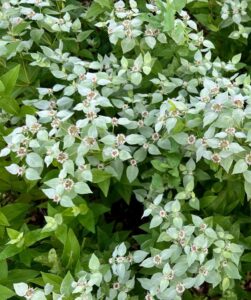 The joy of fall harvest is both satisfying and comforting, as it has been for people here for thousands of years. Bringing in crops from our gardens is part of that, each year yielding sustenance for the coming season. In nature, plants have produced a little extra just in case, and we can take advantage of their fruit and, sometimes, foliage. Animals, too, are most abundant in fall, allowing for a wise harvest if we’re careful.
The joy of fall harvest is both satisfying and comforting, as it has been for people here for thousands of years. Bringing in crops from our gardens is part of that, each year yielding sustenance for the coming season. In nature, plants have produced a little extra just in case, and we can take advantage of their fruit and, sometimes, foliage. Animals, too, are most abundant in fall, allowing for a wise harvest if we’re careful.Among the plants, one group is widely present around us and is often easy to identify- the mints. Their family of plants, the Lamiaceae, have more than 7,000 species worldwide. They are usually identified by their form- they have characteristic square stems and leaves arranged on opposite sides of the stem. Many also have a pungent odor, which in many cases appeals to humans. Many, especially in the Mentha genus, have a characteristically minty smell- like peppermint, spearmint, bergamot, and a number of other wild species. Those in the Saliva genus sometimes have a savory aroma, like basil, sage, oregano, tyme, rosemary, and marjoram. Others just smell sweet, like lavender, lemon balm, and hyssop. And some appeal to species other than humans, like catnip. Some are considered weeds, like creeping Charlie. Some are considered powerful medicines, like heal-all. And some are just pretty, like coleus.
Be it sweet or savory, mints do tend to have a strong smell, and there’s a reason for it- self preservation. In nature, everything consumes something, and insects eat a lot of plants. In general, that’s a very good thing, because plants harvest energy from the sun, and insects consume plants and thus move that energy throughout the world. Mints, however, have developed a chemical defense. Menthol is one of the aromatic chemicals mints use to repel not only chewing insects, but chewing mammals as well- you don’t find deer browsing on the mints. Others include dolichodial, another primary insect deterrent, and phenol. It’s interesting that we’re not repelled by many of them, instead we use them for food or fragrance.
I wouldn’t consider myself a forager, but after harvesting and drying the cultivated mints at home- peppermint, spearmint, rosemary, thyme, and basil for later use, I couldn’t resist taking a few bags along and searching our piece of land for catnip (for my cat-owning children), and mountain mint and bergamot for tea. All are easy to start from seed, and do well here and there around the perimeter of the yard and beyond in grassy areas. Added in were some wild sage and mugwort for their scent. A couple of hours in the food dehydrator and the house was filled with interesting aromas, and a little storage bin was filled with small bags of various minty herbs to be enjoyed later as a reminder of the beauty of fall.
Be careful, though, with non-native cultivated mints, like oregano. These are best grown in pots, as if they escape can take over areas of the garden if left to spread, like creeping Charlie does.
Mints are an interesting group of plants which not only add to our enjoyment of the natural world through their appearance, scent, and taste, but also through their abundance and variety. I’m grateful that they share themselves to make my life a little more interesting.
photo- Mountain Mint by bgwalker
